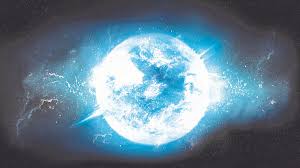White Dwarf:

Astronomers report the detection of four white dwarf stars of a recently discovered rare DAQ spectral subclass.
- A white dwarf is the stellar core left behind after a dying star has exhausted its nuclear fuel and expelled its outer layers to form a planetary nebula. It is what stars like the Sun become after they have exhausted their nuclear fuel.
- White dwarfs no longer support nuclear fusion reactions that generate energy, but they are still extremely hot.
- A typical white dwarf is half as massive as the Sun, yet only slightly bigger than Earth.
- This makes white dwarfs one of the densest collections of matter, surpassed only by neutron stars.
- A newly born white dwarf consists of helium, carbon and oxygen nuclei, swimming in a sea of highly energetic electrons.
- Unlike most other stars that are supported against their own gravitation by normal gas pressure, white dwarf stars are supported by the degeneracy pressure of the electron gas in their interior.
- Degeneracy pressure is the increased resistance exerted by electrons composing the gas, as a result of stellar contraction.
- Unless it is accreting matter from a nearby star, the white dwarf cools down over the next billion years or so.
- It is predicted that they would ultimately form ‘black dwarfs’, although the Universe is likely not old enough for any black dwarfs to exist yet.




